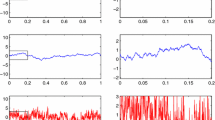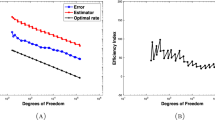Abstract
The main objective of this work is to demonstrate that sharp a posteriori error estimators can be employed as appropriate monitor functions for moving mesh methods. We illustrate the main ideas by considering elliptic obstacle problems. Some important issues such as how to derive the sharp estimators and how to smooth the monitor functions are addressed. The numerical schemes are applied to a number of test problems in two dimensions. It is shown that the moving mesh methods with the proposed monitor functions can effectively capture the free boundaries of the elliptic obstacle problems and reduce the numerical errors arising from the free boundaries.
Similar content being viewed by others
REFERENCES
Ainsworth, M., and Oden, J. T. (1993). A unified approach to a posteriori error estimation using element residual methods. Numer. Math. 65, 23–50.
Ainsworth, M., and Oden, J. T. (1997). A posteiori error estimation in finite element analysis. Comput. Methods Appl. Mech. Engrg. 142, 1–88.
Ainsworth, M., Oden, J. T., and Lee, C. Y. (1993). Local a posteriori error estimators for variational inequalities. Numer. Methods Partial Differential Equations 9, 22–33.
Azarenok, B. N. (2002). Variational barrier method of adaptive grid generation in hyperbolic problems of gas dynamics. SIAM J. Numer. Anal. 40, 651–682.
Baines, M. J. (1994). Moving Finite Elements, Oxford University Press.
Beckett, G., Mackenzie, J. A., Ramage, A., and Sloan, D. M. (2002). Computational solution of two-dimensional unsteady PDEs using moving mesh methods. J. Comput. Phys. 182, 478–495.
Brackbill, J. U., and Saltzman, J. S. (1982). Adaptive zoning for singular problems in two dimensions. J. Comput. Phys. 46, 342–368.
Ceniceros, H. D., and Hou, T. Y. (2001). An efficient dynamically adaptive mesh for potentially singular solutions. J. Comput. Phys. 172, 609–639.
Chen, Z. M., and Nochetto, R. H. (2000). Residual type a posteriori error estimates for elliptic obstacle problems. Numer. Math. 84, 527–548.
Ciarlet, P. G. (1978). The Finite Element Method for Elliptic Problems, North-Holland, Amsterdam.
Davis, S. F., and Flaherty, J. E. (1982). An adaptive finite element method for initial-boundary value problems for partial differential equations. SIAM J. Sci. Stat. Comp. 3, 6–27.
Dvinsky, A. S. (1991). Adaptive grid generation from harmonic maps on Riemannian manifolds. J. Comput. Phys. 95, 450–476.
Elliott, C. M., and Ockendon, J. R. (1982). Weak and Variational Methods for Moving Boundary Problems, Research Notes in Mathematics, Vol. 59, Pitman, Boston.
French, D. A., Larsson, S., and Nochetto, R. H. (2001). A posteriori error estimates for a finite element approximation of the obstacle problem in L∞. Comput. Methods Appl. Math. 1, 18–38.
Friedman, A. (1982). Variational Principles and Free-Boundary Problems, Academic Press, New York.
Glowinski, R., Lions, J. L., and Tremolieres, R. (1976). Numerical Analysis of Variational Inequalities, North-Holland, Amsterdam.
He, B. S. (1994). Solving a class of linear projection equations. Numer. Math. 68, 71–80.
Kinderlehrer, D., and Stampacchia, G. (1980). An Introduction to Variational Inequalities and Their Applications, Academic Press, New York.
Kornhuber, R. (1996). A posteriori error estimates for elliptic variational inequalities. Comput. Math. Appl. 31, 49–60.
Kufner, A., John, O., and Fucik, S. (1977). Function Spaces, Nordhoff, Leyden, The Netherlands.
Li, S., and Petzold, L. (1997). Moving mesh methods with upwinding schemes for time-dependent PDEs. J. Comput. Phys. 131, 368–377.
Li, R., Liu, W. B., Ma, H.-P., and Tang, T. (2002). Adaptive finite element approximation for distributed elliptic optimal control problems. SIAM J. Control Optim. 41, 1321–1349.
Li, R., Tang, T., and Zhang, P. (2001). Moving mesh methods in multiple dimensions based on harmonic maps. J. Comput. Phys. 170, 562–588.
Li, R., Tang, T., and Zhang, P. (2002). A moving mesh finite element algorithm for singular problems in two and three space dimensions. J. Comput. Phys. 177, 365–393.
Liu, W. B., Ma, H.-P., and Tang, T. (2001). Mixed error estimates for elliptic obstacle problems. Adv. Comput. Math. 15, 261–283.
Liu, W. B., and Yan, N. (2000). A posteriori error estimates for a class of variational inequalities. J. Sci. Comput. 35, 361–393.
Miller, K., and Miller, R. N. (1981). Moving finite element methods I. SIAM J. Numer. Anal. 18, 1019–1032.
Ren, Y., and Russell, R. D. (1992). Moving mesh techniques based upon equidistribution, and their stability. SIAM J. Sci. Stat. Comput. 13, 1265–1286.
Tang, H. Z., and Tang, T. (2003). Moving mesh methods for one-and two-dimensional hyperbolic conservation laws. SIAM J. Numer. Anal. 41, 487–515.
Verfurth, R. (1989). A posteriori error estimators for the Stokers equations. Numer. Math. 55, 309–325.
Verfurth, R. (1996). A Review of a posteriori Error Estimation and Adaptive Mesh-Refinement Techniques, Wiley-Teubner.
Winslow, A. (1967). Numerical solution of the quasi-linear Poission equation in a nonuniform triangle mesh. J. Comput. Phys. 1, 149–172.
Author information
Authors and Affiliations
Rights and permissions
About this article
Cite this article
Li, R., Liu, W.B. & Ma, H.P. Moving Mesh Method with Error-Estimator-Based Monitor and Its Applications to Static Obstacle Problem. Journal of Scientific Computing 21, 31–55 (2004). https://doi.org/10.1023/B:JOMP.0000027954.83289.00
Issue Date:
DOI: https://doi.org/10.1023/B:JOMP.0000027954.83289.00




